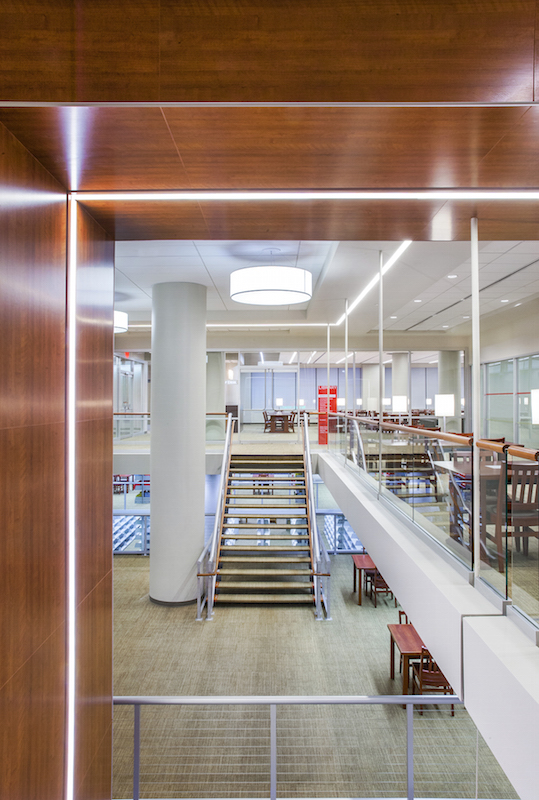Libraries remain one of the typologies that colleges and universities continue to invest in avidly. And most new construction and renovation seems to focus on creating spaces where students and even faculty can collaborate.
A recent example is the $15 million, 21,000-sf expansion of LaGuardia Community College in Long Island City, N.Y., which debuted May 12. This library, with more than 650,000 visitors annually, is one of the campus’s most heavily used spaces, and its expansion “is long overdue,” says the college’s president Gail O. Mellow.
The expansion converted a section of the second floor at the college’s E-building, which had been used for offices and classrooms, into more library space above the library’s existing mezzanine. It made the existing, previously single-floor, library 60% larger, and increased its seating capacity 74% to 732 by adding 312 workstations powered by Internet connections in each.
The new floor includes a 5,750-sf courtyard reading room, the 2,790-sf Thomson Reading Room, a 1,570-sf media lab, 1,360-sf archive room, a video editing room, a recording room, a language lab, offices, 11 group study rooms, restrooms, storage spaces, and mechanical and data rooms. There are also 50 new offices.
To achieve this expansion, the construction team—which included IBI Group Gruzen Samton (architect), Stalco Construction (GC), and AECOM (CM)—removed the original stairs from the main floor to the mezzanine, and cut a 50x60-ft opening into the concrete slab of the second-floor library space for a new structural steel staircase with wooden treads and handrails.

The construction team cut a 50x60-ft opening in the concrete slab of the new second-floor library space to accommodate a new staircase. Image: Ola Photography
The opening of the second floor is an architectural feature with glass sides that allow patrons to see into the library.
The challenges of this project included working while the existing library was in operation. Construction crews accessed the site through the exterior wall opening, and materials deliveries came through a ramp or a hoist through the second-floor opening. (The new stair was carried in sections through the exterior all and assembled onsite.) The crews never had access to the building’s elevator.
A temporary wall mitigated noise and dust. And when possible, the crews worked while students were away, on weekends and during spring break.
Other stakeholders on this project included the Dormitory Authority of the State of New York. LaGuardia Community College is part of the City University of New York system, and educates 50,000 New Yorkers annually. Its student population is largely lower-income, new-immigrant, or otherwise disadvantaged.
The Building Team included Joseph R. Loring & Associates (MEP), Ysrael A. Seinuk, P.C. (SE), and Whitehouse Lighting Design (lighting). The library’s atrium space above the stair features three oversized round light fixtures, which can be lowered automatically for maintenance.
Phase 2 of this project will focus on the first floor, and renovations will be based in part on input from students, faculty, and staff, according to the college
Related Stories
| Aug 11, 2010
Community college’s hillside learning center
The Earl E. and Dorothy J. Dellinger Learning Resource Center at Southwest Virginia Community College in Richlands, Va., is the centerpiece of this mountainside school. Designed by Arlington, Va.-based The Lukmire Partnership, the 50,000-sf, two-story building connects the upper and lower campuses, which are separated by a 70-foot vertical grade change.
| Aug 11, 2010
BIG beats out Foster and Hadid in design competition for Kazakhstan's National Library
Invited as one of five pre-selected architect-led teams that included Lord Norman Foster and Zaha Hadid, Copenhagen-based BIG was awarded first prize in an international design competition for the new National Library in Astana, Kazakhstan. The 33,000-square-meter facility will be organized as a “circular loop of knowledge” that allows for clear, intuitive orientation of the vast co...
| Aug 11, 2010
Modest recession for education construction
Construction spending for education expanded modestly but steadily through March, while at the same time growth for other institutional construction had stalled earlier in 2009. Education spending is now at or near the peak for this building cycle. The value of education starts is off 9% year-to-date compared to 2008.
| Aug 11, 2010
Concrete Solutions
About five or six years ago, officials at the University of California at Berkeley came to the conclusion that they needed to build a proper home for the university's collection of 900,000 rare Chinese, Japanese, and Korean books and materials. East Asian studies is an important curriculum at Berkeley, with more than 70 scholars teaching some 200 courses devoted to the topic, and Berkeley's pro...
Cultural Facilities | Aug 11, 2010
12 major trends in library design
Many academic planners assumed that the coming of the Internet would lead to the decline of the library as we know it. To the contrary, many academic libraries have experienced significantly increased patron use in recent years.
| Aug 11, 2010
Giants 300 University Report
University construction spending is 13% higher than a year ago—mostly for residence halls and infrastructure on public campuses—and is expected to slip less than 5% over the next two years. However, the value of starts dropped about 10% in recent months and will not return to the 2007–08 peak for about two years.
| Aug 11, 2010
Let There Be Daylight
The new public library in Champaign, Ill., is drawing 2,100 patrons a day, up from 1,600 in 2007. The 122,600-sf facility, which opened in January 2008, certainly benefits from amenities that the old 40,000-sf library didn't have—electronic check-in and check-out, new computers, an onsite coffeehouse.
| Aug 11, 2010
Fleet Library, Rhode Island School of Design
When tasked with transforming an early 1920s Italian Renaissance bank building into a fully functional library for the Rhode Island School of Design, the Building Team for RISD's Fleet Library found itself at odds with the project's two main goals. On the one hand, the team would have to carefully restore and preserve the historic charm and ornate architectural details of the landmark space, d...








